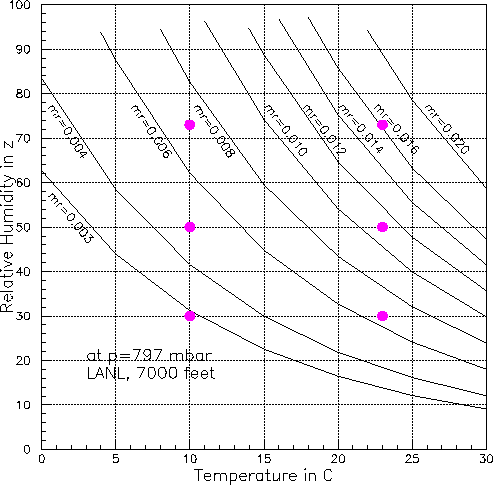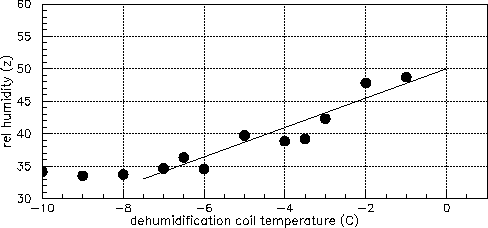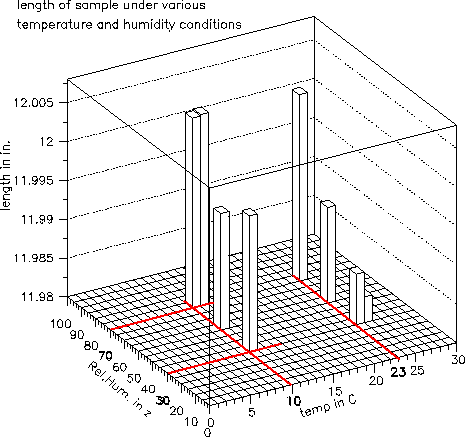
The values are for sea level, and were calculated starting with the tools here.
ps version

| This plot shows the relation between temperature,
relative humidity and absolute humidity, expressed as the mixing ratio) The values are for sea level, and were calculated starting with the tools here. ps version |

| Here are the same curves for an altitude of 7000 feet. Note there is a
considerable shift relative to sea level. The dots indicate points where length measurements were taken on a rohacell sample. Results are further down on this page. ps version |
 ps version
ps version
The humidity can be controlled by lowering the coil temperature, shown here in the 'short loop', where the output air is directly recirculated to the filter housing. The circulating air temperature is 160C at -4, and 130C at -10. The graph shows we can not do better than 50% RH at 00, and that would be at a temperature of about 180 for the circulating air. The RH would be higher at lower temperatures. |
 The dehumidification coils must be operated below the dewpoint in order for
condensation to form, but the main cooling radiators must stay above the
dewpoint. The diagram shows that if the relative humidity is high, you cannot
run the radiators much below the target temperature. For example, at a
temperature of 100C the radiator must be run above 50C.
The dehumidification coils must be operated below the dewpoint in order for
condensation to form, but the main cooling radiators must stay above the
dewpoint. The diagram shows that if the relative humidity is high, you cannot
run the radiators much below the target temperature. For example, at a
temperature of 100C the radiator must be run above 50C.
ps version |
 ps version.
ps version.
The MVD will be assembled at room temperature, about 230C. It will be operated at about 100C. We need to determine if the Rohacell dimensions depend on relative humidity or on mixing ratio. This plot shows the length of an uncoated sample of Rohacell at dfferent temperatures and humidities. The locations of the measurements correspond to the pink dots in the temperature-humidity diagram above. The partially hidden 'second columns' are where I went back to the same point and re-did the measurements. Just in case there are questions of time and hysteresis, here are the raw data: |
| day/time | temperature | humidity | lengths | average | |
|---|---|---|---|---|---|
| 2 | thu 10:20 | 23 | 73 | 12.007 12.002 12.006 12.001 | 12.0040 |
| 3 | thu 18:00 | 10 | 73 | 12.003 12.006 12.004 12.005 | 12.0045 |
| 4 | fri 09:20 | 10 | 33 | 11.994 12.000 11.996 12.000 | 11.9975 |
| 5 | fri 17:45 | 23 | 30 | 11.984 11.989 11.985 11.988 | 11.9865 |
| 6 | mon 09:30 | 23 | 50 | 11.991 11.993 11.991 11.997 | 11.9923 |
| 7 | tue 09:10 | 10 | 50 | 11.991 11.997 11.995 11.997 | 11.9950 |
| 8 | wed 09:30 | 10 | 70 | 12.001,4,5,8,4,6 | 12.0047 |
| 9 | thu 09:10 | 23 | 30 | 11.981,3,3,5,1,7 | 11.9833 |
| 10 | fri 10 | 16 | 30 | ||
| 11 | |||||
| 12 | |||||
| 13 | |||||
| 14 | (ongoing) |